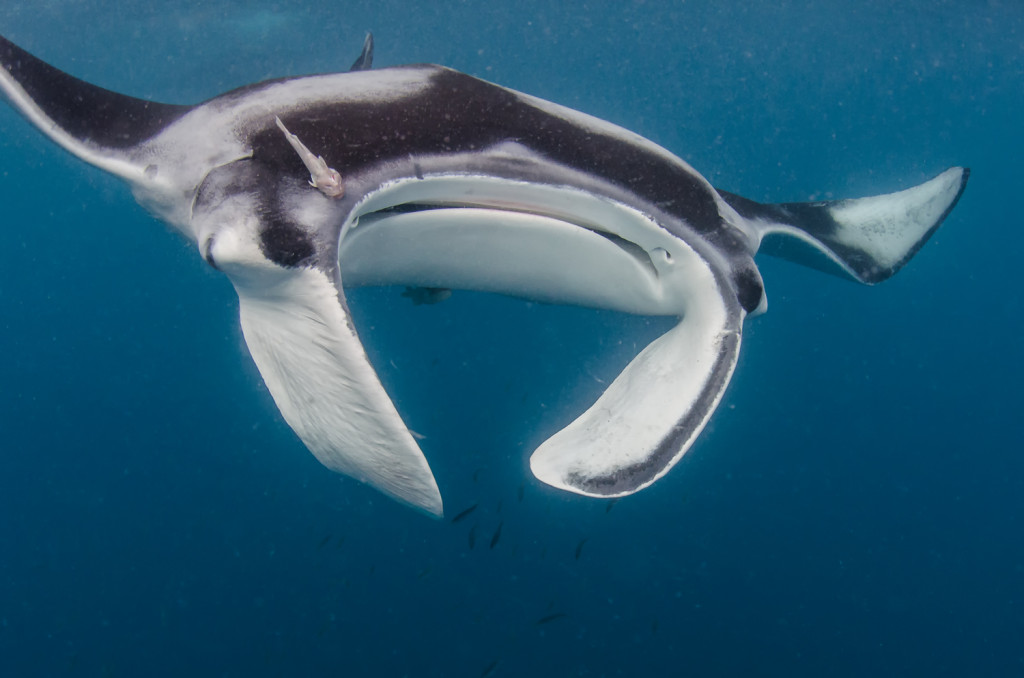
As travelers, we’ve been remarkably lucky, with very few hiccups along the way, especially given the number of miles we’ve logged. Catch up was inevitable. Our return to Isla Mujeres, this time in pursuit of sailfish, themselves in pursuit of swirling baitballs of small silver anchovies, had a bumpy start. The astute reader will have already noticed a disconnect between the stated aim of this expedition, namely sailfish, and the manta ray in the featured image.
We were all set. Our friend Greg, a fellow foodie and underwater photographer, former chocolate empresario and now actor, was already in Playa del Carmen, awaiting our arrival. Our plans included a bull shark dive (yes, the most unpredictable and therefore, perhaps the most dangerous shark and no, not in cages), 2 days exploring freshwater cenotes 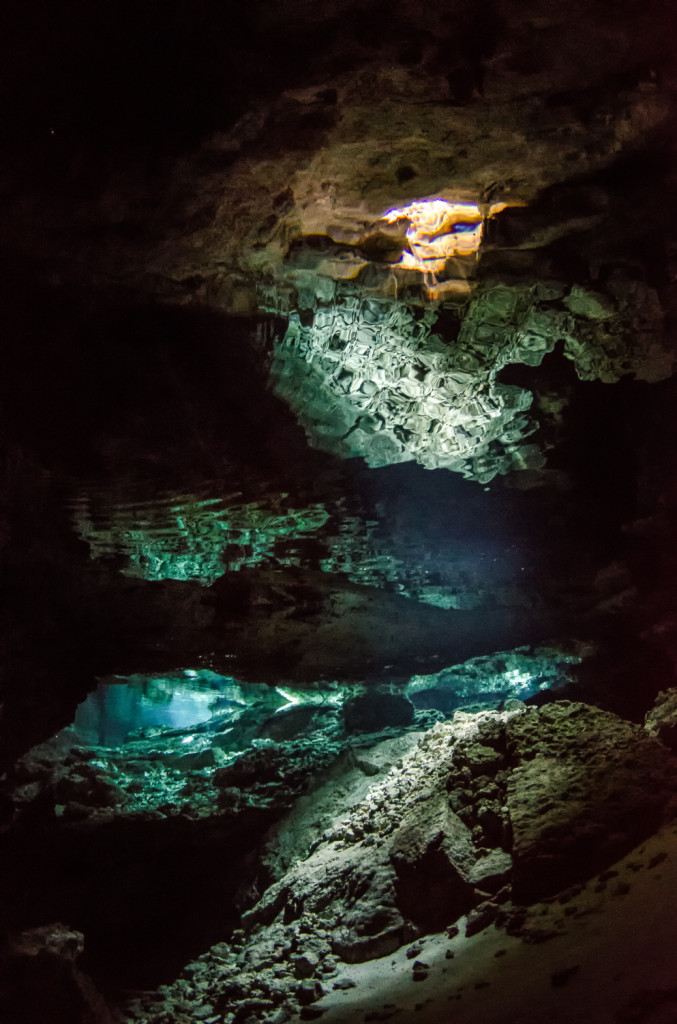 and then on to Isla Mujeres for the main course, joining up with Shawn Heinrichs and Jim Abernathy, and hopefully, sailfish rounding up baitballs. We met Shawn 5 years ago in South Africa, on a largely unsuccessful sardine run off the eastern “Wild Coast.” He is an ardent advocate for marine conservation and accomplished professional underwater photographer and videographer. Jim Abernathy is a well known Florida dive figure, owner of the Shear Water liveaboard dive boat, very well known for his passion for sharks.
and then on to Isla Mujeres for the main course, joining up with Shawn Heinrichs and Jim Abernathy, and hopefully, sailfish rounding up baitballs. We met Shawn 5 years ago in South Africa, on a largely unsuccessful sardine run off the eastern “Wild Coast.” He is an ardent advocate for marine conservation and accomplished professional underwater photographer and videographer. Jim Abernathy is a well known Florida dive figure, owner of the Shear Water liveaboard dive boat, very well known for his passion for sharks.
We had never met him, but knew of him, including from Greg who had done a prior trip with him.
Greg’s trip had a rough start as well. As we hurtled around the house on a Friday night after work, rounding up the scattered diaspora of diving and photography gear from all corners of the house, we received this email:
“Pulled a genius one this morning. All set to go and realized my passport was locked in a file at my office and only the secretaries would know where the key was hidden. Neither one gets in before 8:30. Rescheduled from a nonstop to a routing through Houston. Got on the plane in Chicago and my back was killing me, slept wrong. My seat is in (b)us(iness) but doesn’t recline. Was all settled into miserable when I was told to go forward. Ended up in first for both legs. Arrived at the hotel after 10pm.”
We were expecting smooth sailing, first to DFW, then on to Cancun. I thought we were off to a propitious start, heralded by an upgrade to Business on the second leg. Marvin from Clayton Transport came to pick us up, so no wrestling our 5 bags and 2 backpacks of dive and photo gear onto shuttles. We sailed through security, thanks to TSA PreCheck. We settled into our bulkhead seats, and awaited our departure.
After the plane was fully loaded and the doors closed, came these ominous words from the pilot:
“I have some news, and I’m afraid it’s not good.”
Something about an indicator, nose cone, and the plane needing to be JACKED UP to be thoroughly checked out. An entire planeload of people disembarked and scrambled for alternatives.
Rescheduling by phone from the airport was smooth enough. We were quickly rebooked onto the next flight to DFW, an hour later, even given exit row seats. The bad news: we wouldn’t arrive in time for our flight to Cancun, the last one of the day, missing it by a mere half hour. Overnighting in DFW it was, and on to Cancun in the morning. I put the Iphone to work, sending texts and emails to reschedule our airport pick-up, our dive in the morning and to let Greg know he was on his own for a while longer.
We had initially planned a Sunday morning bull shark dive, with Monday and Tuesday reserved for the cenotes. Those plans were in flux even before we left, as we learned from Jose at Eco-Divers that the bull sharks were not being sighted in the expected aggregations, thanks to unexpectedly warm ocean water temperatures, perhaps the lunar phase and even a rogue local fisherman was implicated.
In San Diego, we’d been given new baggage tracking numbers and told to pick up our bags in DFW. So, we waited for them…and waited. Eventually, we caught on- they didn’t make the trip with us. Our handwritten bag tracking numbers were no good…it seemed our original flight did eventually go, hours later and would be due later. So, we headed outside to catch the terminal shuttle to stay at the Grand Hyatt, run by DFW airport, and had a nasty surprise-frigid 40 degree weather outside, for which we were ill prepared in our ready-for-Cancun travel clothes.
The Grand Hyatt proved to be a very pleasant oasis, attractive and contemporary, with interesting, large scale abstract “Decompressionism” photographic art by Richard Bettinger . We were upgraded into a gorgeous suite, which eased the inconvenience of having no toiletries or change of clothes. The restaurant was also beautiful, with farm to table offerings…we could hardly believe we were in an airport. Even the menu was a first, LED panels transilluminating the printed pages.
We thoroughly enjoyed sampling an array of starters (tortilla soup, sous vide halibut cheeks, scallops, beet and carrot salad with chèvre) and shared an entree, chickpea curry with rice, all accompanied by a very pleasant Brennan Vineyards 2011Texas Hill Country Viognier. Yes, that’s right, y’all. The back of the bottle description was encouraging (Sophisticated wine with Texas roots) and a crack up: “How do you say VEE-ON-YAY?”
Thankfully, there were no adventures or untoward occurrences the next morning. The Grand Hyatt breakfast of chilliquiles and fresh squeezed orange juice was a great Tex-Mex culinary kick-off to see us off to Cancun.
Greg was off diving when we arrived in Playa del Carmen, giving us time to build our cameras and organize our dive gear. He spent the day at Dos Ojos (2 eyes), a well known cenote, with Carlos, our guide from Eco-Divers. After dinner, we had a preview of his images, hoping to shorten our cenote photography learning curve. Dinner was at a delicious Mayan speciality restaurant, Yaxché (pronounced Jag-shey) on the main drag. We sampled 3 appetizers (Papadzul, quail egg stuffed tortilla with pumpkin seed sauce and epazote herb infused tomatos; Sakan Chay, corn and local black eyed pea stuffed patties with coriander cream, and terrific ceviche) and 3 equally delicious entrees. Cochinita Pibil is a pork dish, marinated in axiote and sour orange, which is slow cooked in a stone oven. We also loved the tikin xic fish, marinated and grilled fish wrapped in a banana leaf.
The Yucatan peninsula is essentially a lattice of limestone, fenestrated by a vast network of underground rivers and lakes, communicating with the ocean. In places, the roof has collapsed, forming pools and allowing access to this system, much of which is still unexplored. The word cenotes is of Mayan origin, meaning water-filled cavern.
Our prior experience with fresh water cenote diving was based on a one day introduction back in August 2013, when we came over on the ferry from Isla Mujeres to see if we would like it. Like it we did-incredibly clear and still water, interesting formations and light play, wearing half the weight required for ocean diving (4 pounds for me) and not having to rinse our gear- all pluses. The only minuses were minor-some gear schlepping over rough terrain, and relatively cold water, a stable 78 degrees. Most of the cenotes are on private lands. Depending on the owner, the facilities range from primitive to more full service, some even with food options. Most of them have some restroom facilities, benches and tables for gearing up, and steps to the entry, usually a pond opening to the surface. Prescribed routes have been mapped out through the cenotes, marked by guidelines. Off limits and uncharted options are signed with ominous wording and a drawing of the Grim Reaper for emphasis:
“STOP. PREVENT YOUR DEATH. GO NO FURTHER.”
This is considered cavern diving, and doesn’t require cave certification (which we don’t have). Diving is guided, with no more than 4 divers to a double tank toting guide, and confined to marked routes. 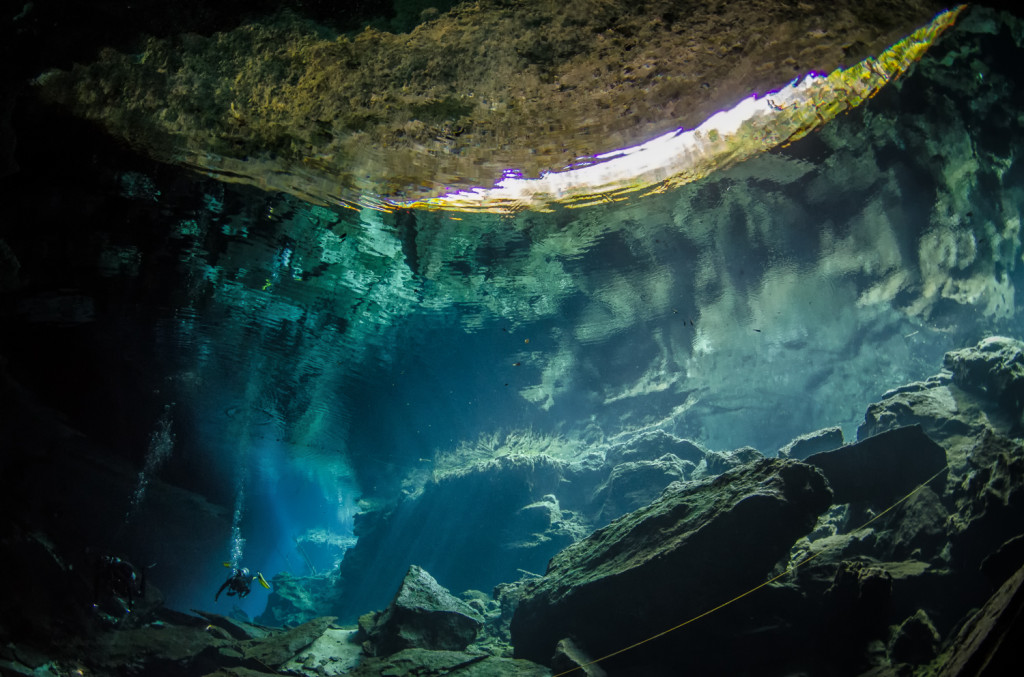 These routes have relatively short overhead sections, with an entrance or exit usually visible. I had been struck by the uniqueness of this environment on our prior foray. On the one hand, it seemed a potentially perfect novice dive, being completely still water (no wave action, surge or current), with incredible water clarity . On the other, the extreme clarity of the water was almost disorienting, almost without cues as to depth and there is real potential for disorientation and claustrophobia induced by sections of extreme dark, overhead coverage and occasional haloclines. A halocline occurs where there is an intersection of fresh water above heavier salt water below. Entering a halocline is bizarre-suddenly, you can no longer read your gauges, focus your camera and even your companions a few feet in front of you are reduced to blurry shapes and lights. A fascinating experience, but it was a relief to pass through it and see again clearly.
These routes have relatively short overhead sections, with an entrance or exit usually visible. I had been struck by the uniqueness of this environment on our prior foray. On the one hand, it seemed a potentially perfect novice dive, being completely still water (no wave action, surge or current), with incredible water clarity . On the other, the extreme clarity of the water was almost disorienting, almost without cues as to depth and there is real potential for disorientation and claustrophobia induced by sections of extreme dark, overhead coverage and occasional haloclines. A halocline occurs where there is an intersection of fresh water above heavier salt water below. Entering a halocline is bizarre-suddenly, you can no longer read your gauges, focus your camera and even your companions a few feet in front of you are reduced to blurry shapes and lights. A fascinating experience, but it was a relief to pass through it and see again clearly.
Our first day in Chac Mool cenote deepened our appreciation of these marvelous and mysterious caverns.  We did 2 dives, Kukulcan and Little Brother. Thankfully, Carlos didn’t tell us until the following morning that Chac Mool had been closed for months after an incident in 2012 in which 3 divers died, a Brazilian couple on their honeymoon and their Spanish guide. Hearing the story was chilling and a reminder of the potential danger in this environment. Apparently, the trio had already done 2 dives that day at Dos Ojos, and didn’t enter Chac Mool until relatively late, about 4 pm. Their guide entered wearing the same set of double tanks. They were found beyond cavern diving limits with their air supplies exhausted. Probably, they entered an off limits cave intending to have a look around, became disoriented and instead of retracing their route, penetrated even further into uncharted territory to their deaths. Although sobering to learn this, it seems anomalous overall, considering this was the first accident of this type (a chain of human error, as opposed to, say, an in water heart attack) since the 1990s.
We did 2 dives, Kukulcan and Little Brother. Thankfully, Carlos didn’t tell us until the following morning that Chac Mool had been closed for months after an incident in 2012 in which 3 divers died, a Brazilian couple on their honeymoon and their Spanish guide. Hearing the story was chilling and a reminder of the potential danger in this environment. Apparently, the trio had already done 2 dives that day at Dos Ojos, and didn’t enter Chac Mool until relatively late, about 4 pm. Their guide entered wearing the same set of double tanks. They were found beyond cavern diving limits with their air supplies exhausted. Probably, they entered an off limits cave intending to have a look around, became disoriented and instead of retracing their route, penetrated even further into uncharted territory to their deaths. Although sobering to learn this, it seems anomalous overall, considering this was the first accident of this type (a chain of human error, as opposed to, say, an in water heart attack) since the 1990s.
We had worked up an appetite by the time we strolled the main drag, ending up in a place we had noticed the night before, Cenacolo (Italian for Last Supper), drawn in by the promise of fresh pasta, being made by a toque-topped chef stationed out. 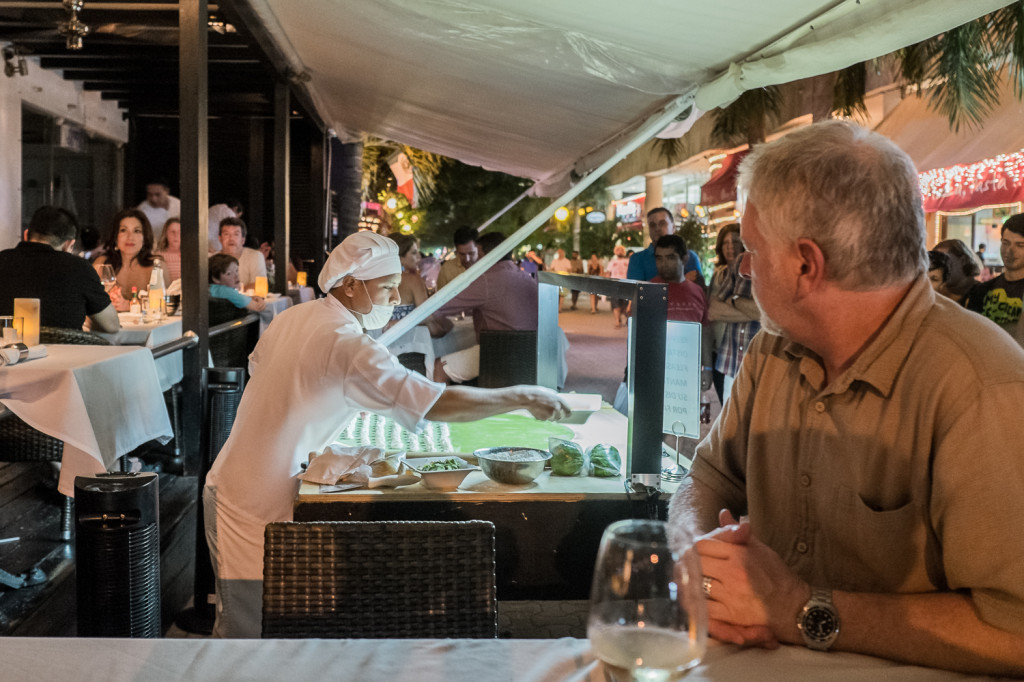 I ordered what we were watching being made, the “little green hats” pasta, zucchini and artichoke stuffed, with a cream sauce. The corner ice cream place, Aldo’s, was, as usual, our final stop.
I ordered what we were watching being made, the “little green hats” pasta, zucchini and artichoke stuffed, with a cream sauce. The corner ice cream place, Aldo’s, was, as usual, our final stop.
Cenote day 2, first to Tajma Ha, which was indeed grand.

Pyramid like rock stack and reflection in Tajma Ha cenote reminded me of the dual planets in the film “Upside Down.”
We were awed by the pyramid like stack of rock reflected on the surface, set off by a lazer like focused beam of light.  We didn’t think that could be topped, but Carlos had an ace up his sleeve.
We didn’t think that could be topped, but Carlos had an ace up his sleeve.  One of his favorites, Pet Cemetery, down the road from Dos Ojos, is named for animal skeletons found in this narrow maze of a cave. Carlos seemed impressed with our air consumption. Even adhering to the rule of thirds (one third of the air supply allotted to going, one third for returning and one third in reserve, just in case), our dives were 80 minutes long. I was surprised to hear most guided dives are over in 40 minutes. He seemed also to have sized us up as capable of the very precise bouyancy control necessary to stay in the narrow band of water between the soft, silty bottom and the intricate array of overhead stalagtites.
One of his favorites, Pet Cemetery, down the road from Dos Ojos, is named for animal skeletons found in this narrow maze of a cave. Carlos seemed impressed with our air consumption. Even adhering to the rule of thirds (one third of the air supply allotted to going, one third for returning and one third in reserve, just in case), our dives were 80 minutes long. I was surprised to hear most guided dives are over in 40 minutes. He seemed also to have sized us up as capable of the very precise bouyancy control necessary to stay in the narrow band of water between the soft, silty bottom and the intricate array of overhead stalagtites.
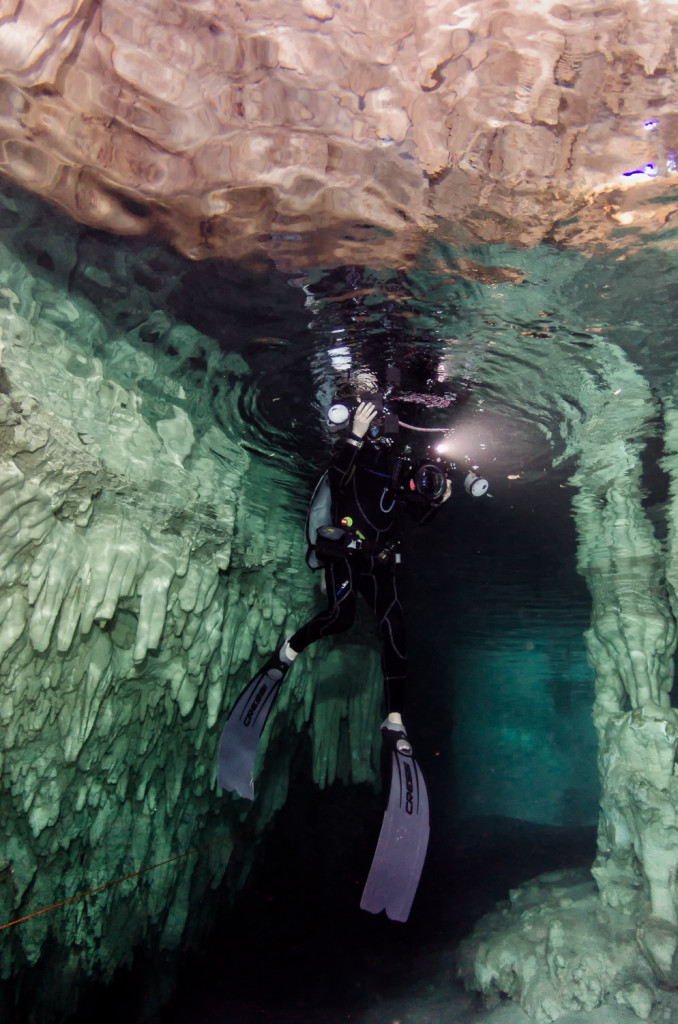
Greg at work, Pet Cemetary cenote, careful not to stir up the bottom, even with those extra long fins
It was visually staggering, nature’s Gothic cathedral.
At the staging areas, we heard many other languages-clearly, the cenotes are an internationally known dive experience. We learned from Carlos that 80% of the dive guides in the area are non-Mexican. Most come from Europe and are multi-lingual, from relatively affluent families, at least compared to the majority of Mexicans, for whom diving is relatively expensive. It is a particular focus of Jose’s to lower the barriers to experience diving to Mexicans and encourage aspiring Mexican dive professionals.
We spent so much time underwater, we had to race back, skipping lunch, hastily packing for our 4 pm pick-up, and hour drive to the ferry terminal. We arrived minutes before the 5:30 ferry. Greg transformed himself into a human beast of burden, thanks to the Porter case, once again proving what a capable butler he is. He really did singlehandedly wrestle fully half of our luggage, plus his camera in one hand, and his dive gear in his mesh backpack. We arrived panting on the dock, after the gate was closed and were initially denied admission. Somehow, something changed, and we were waved on. Upstairs, a gorgeous sunset over Cancun sent us on our way to Isla Mujeres.
With the aid of a malatero wielding a bicycle driven cart over the cobblestone streets, we made our way on foot to the meetup hotel, Playa Media Luna, a few minutes in advance of trip leaders Shawn and Jim Abernathy. We had a not-that-brief briefing on what to expect and how we would organize ourselves to hold up the baitballs and witness the frenzy of the feeding sailfish. Backs to the sun, we would interpose ourselves in a line between the sun and the baitball, hoping to cause the baitfish to realize we are not also predators. Our distance to the baitball would be close or more distant, depending on the objectives. Questions were entertained as well, including a particularly entertaining one from Angela, from Germany, as to whether a sailfish could penetrate a wetsuit . The answer to this, especially after Jim’s characterization of a sailfish as 70 pounds of muscle with a sword at one end, seemed evident to us. (The answer: YES). But no, this wasn’t likely.
Not having eaten all day, we ate at Casa de los Suenos, after being greeted with refreshing mojitos.
The coconut shrimp and shrimp ceviche outshown the guacamole as starters. Their version of tikin xic fish was too salty and disappointing.
Our first foray on the open ocean in search of sailfish can only be termed a total bust.
Waiting, hoping, sweating, stuporous, eventually we jumped into the water just to cool off. Dolphins prompted our entry, and the other group had brief sightings of sailfish, fleeting swim-bys. Ironically, the closest encounter was not seen by the recipient. Curtis apparently was struck on the forehead by the boat on entering, and was bleeding profusely, so much he didn’t see a sailfish stop and check him out from a few feet away.
Day 2 was only minimally more encouraging. 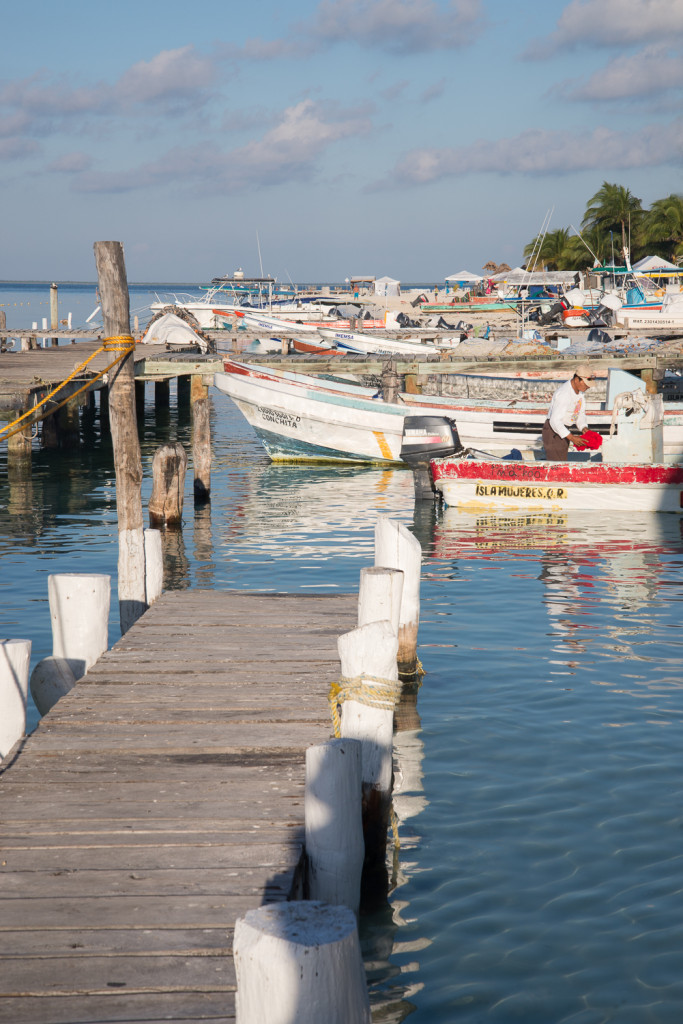 Again, we met at 6:45 and took off from the dock around 7:15, steaming north for miles, watching and waiting.
Again, we met at 6:45 and took off from the dock around 7:15, steaming north for miles, watching and waiting.
Shawn had told us that our signal for the presence of underwater baitballs and sailfish would be frigate birds circling overhead. The more birds, the tighter and the lower they were flying, the higher the likelihood of finding the action we sought. This day, we actually saw some bird aggregations, as well as a baitball, but no prolonged or satisfying encounters.
Dinner was a hole-in-the-wall place, Loncheria El Poc-Chuc, a block off the main strip, brightly lit, with great guacamole and shrimp ceviche. Greg and I shared enchiladas verdes and chicken enchiladas with mole sauce, and had trouble deciding which ones we liked best-they were both delicious.
Day 3 was more of the same, monotonous, even quieter than the 2 prior days. This time, I at least brought some entertainment-my phone, with a newly installed Kindle app. I started reading The Tiger’s Wife at 50% power down until it shut off. There were few birds, certainly no aggregations. We didn’t even get into the water until late afternoon, and that was just to get wet. A large patch of algea, a nursery for tiny fishes, help out hope of finding a sargassum frogfish, but to no avail.
Greg, Steve and I had dinner locally, at the Soggy Peso, an expat hang-out we had heard about from our prior house exchangers. The crispy tacos were tasty enough, and the guacamole fresh and yummy, but the sunburnt, woo-hoo gringo crowd was too raucous for our taste. The dark patio and poolside garden was much more pleasant when the crowd thinned.
We finally broke our nothing-happening streak on day 4, although still no sailfish. We did have long, satisfying swimming sessions with other large fauna, namely manta and mobula rays in the morning and whalesharks in the afternoon. We were steaming north from Isla Mujeres when the radio crackled to life with reports of many mantas and mobula rays near Isla Contoy.  On arrival, we could see manta wing slaps in the water all around the boat, and found them to be huge, and very approachable.
On arrival, we could see manta wing slaps in the water all around the boat, and found them to be huge, and very approachable.
Later, whalesharks were reported 12 miles and 1 hour away-did we want to go?  Yes! One would think we would have had our fill of whalesharks, having spent 3 whole days surrounded by hundreds last August, in the middle of the official whaleshark season (June-September).
Yes! One would think we would have had our fill of whalesharks, having spent 3 whole days surrounded by hundreds last August, in the middle of the official whaleshark season (June-September).  This time, although there were fewer whalesharks, we had the smaller group to ourselves, with only one other boat of snorkelers to dodge, versus the 70 or so boats present in the summer.
This time, although there were fewer whalesharks, we had the smaller group to ourselves, with only one other boat of snorkelers to dodge, versus the 70 or so boats present in the summer.
The water was a slick of fish eggs, which we felt as tiny pelts on our faces, and which dotted our skin and wetsuits when we finally flopped into the boat in the afternoon. To experience what it is to swim with a giant like this, here is a video clip link: https://vimeo.com/95237912
These behemoths cruise through the ocean with their giant mouths open, gulping mass quantities of plankton enriched water. See it from a planktonic particle point of view here: https://vimeo.com/95237913
Sadly, our final shot at sailfish encounters, day # 5, was quiet, dead really, no action of any kind. We jumped in the water only once, in time to see a rapidly receding manta which was clearly not ready for a close-up. Jim kept our boat entertained with tales from his fearless youth, including an account of the last fish (a giant grouper) he hunted, a behemoth which engulfed his head and shoulders in a narrow drainage pipe at 70 feet, knocking his regulator and mask off.  This tale of karmic retribution sounded unsurvivable to mere mortals like us.
This tale of karmic retribution sounded unsurvivable to mere mortals like us.
We were to meet more larger than life characters at our final dinner, which included an underwater model, Roberta Mancino, and fellow high speed professional skydiver and BASE jumper, Jeb Corliss, guests arriving for the following week’s sailfish hunt. After meeting them, we were later stunned watching You-tubes of their Red Bull and GoPro sponsored stunts, high risk feats such as flying through the air in inflatable wingsuits, threading through obstacles. Swimming with sword-wielding fish in hot pursuit of baitfish and being used for cover seemed relatively tame compared with some of the stunts this couple have done, but that’s just conjecture on my part…it’ll have to wait for a return to Isla Mujeres and better luck next time to see for ourselves.
Our final trip to the pier by golf cart, weighed down by the 3 of us and all of our gear, seemed destined for an ignominious finale…the golf cart putt-putted along, hesitating, spluttering, seeming on the verge of giving it up half-way to town, not dissimilar to a trip we did with Greg years back to Bonaire the week of a total solar eclipse. To be sure of experiencing totality, we went into the open ocean by boat, only to run out of gas on the return, about half a mile from the dock. Somehow, willing the cart to hold it together, we limped to the dock. We had bought tickets for the ferry the day before to streamline our return, completely forgetting there are 2 ferry lines, next door to each other on Isla, 4 blocks apart on the Cancun side. Only when we were greeted by Captain Hook on arriving to the mainland did we realize our mistake. No problem, I headed off by foot to find our driver at the other landing to have them come to collect us and our gear. Greg took a picture of me as I departed on foot, lest that be my last known sighting. No need to look for me on a milk carton, I’m writing this from home, reflecting on the vagaries of underwater safaris, the luck of the draw, and trying to remember that you have to be out there for chance to favor you.
-Marie

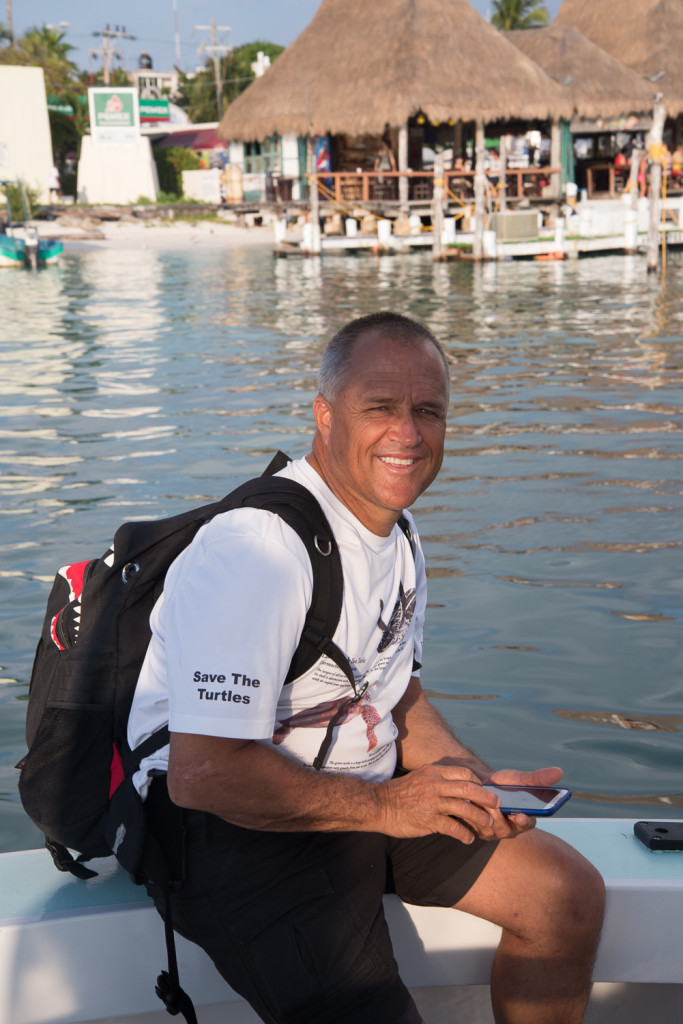
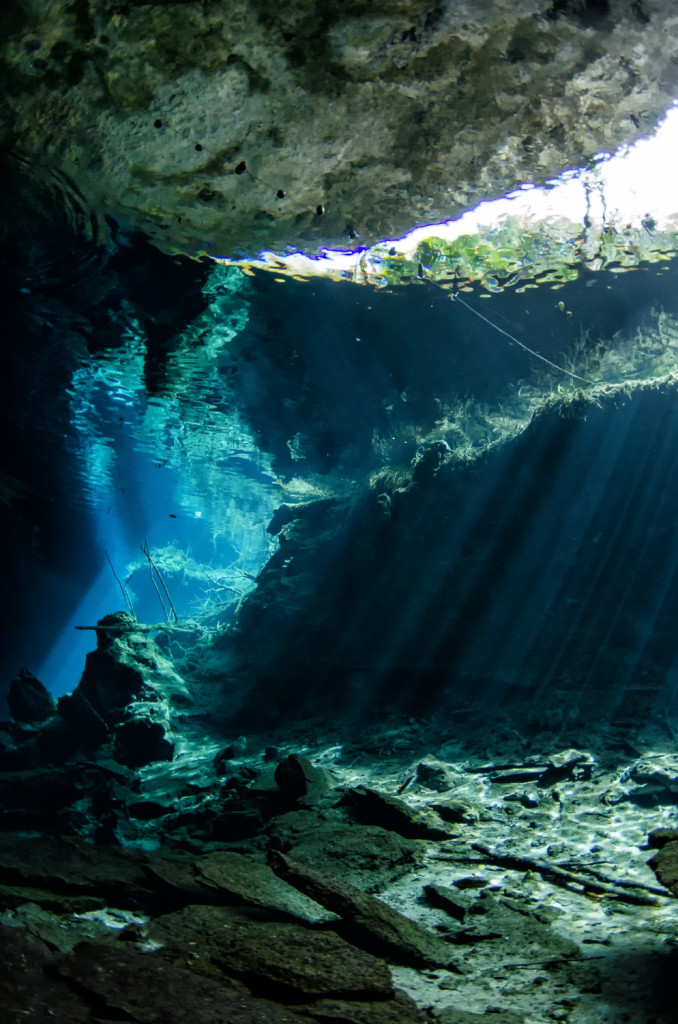
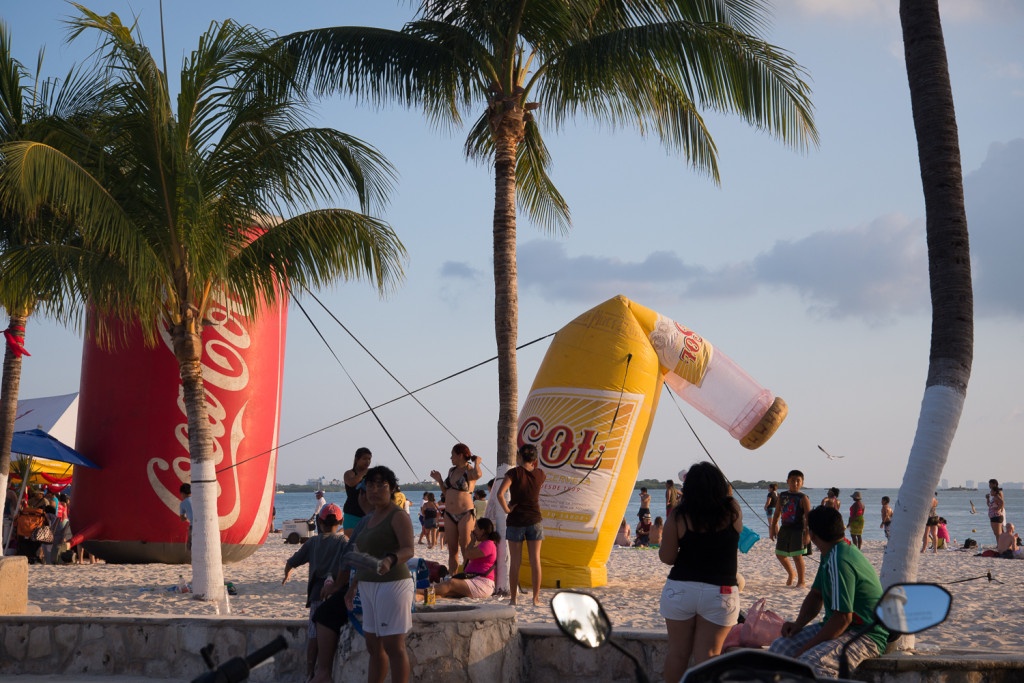
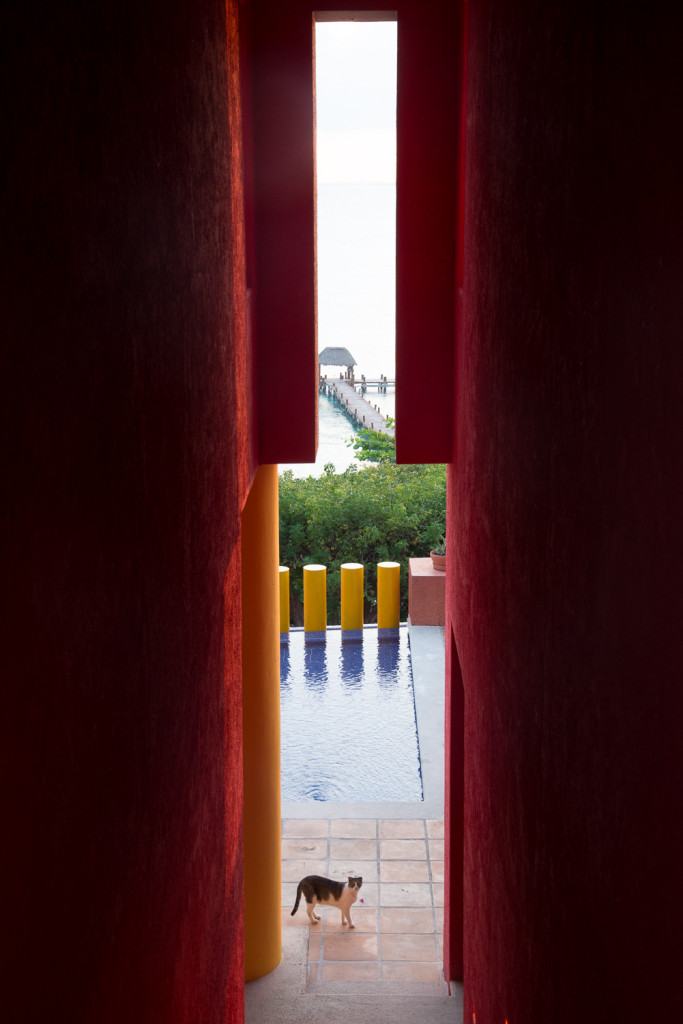
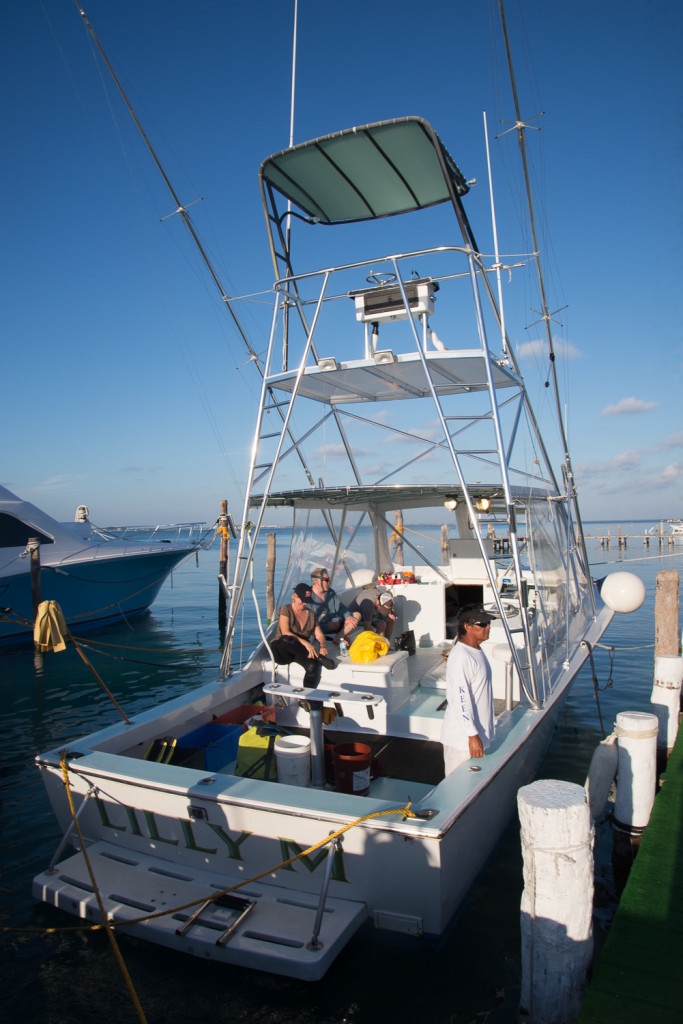


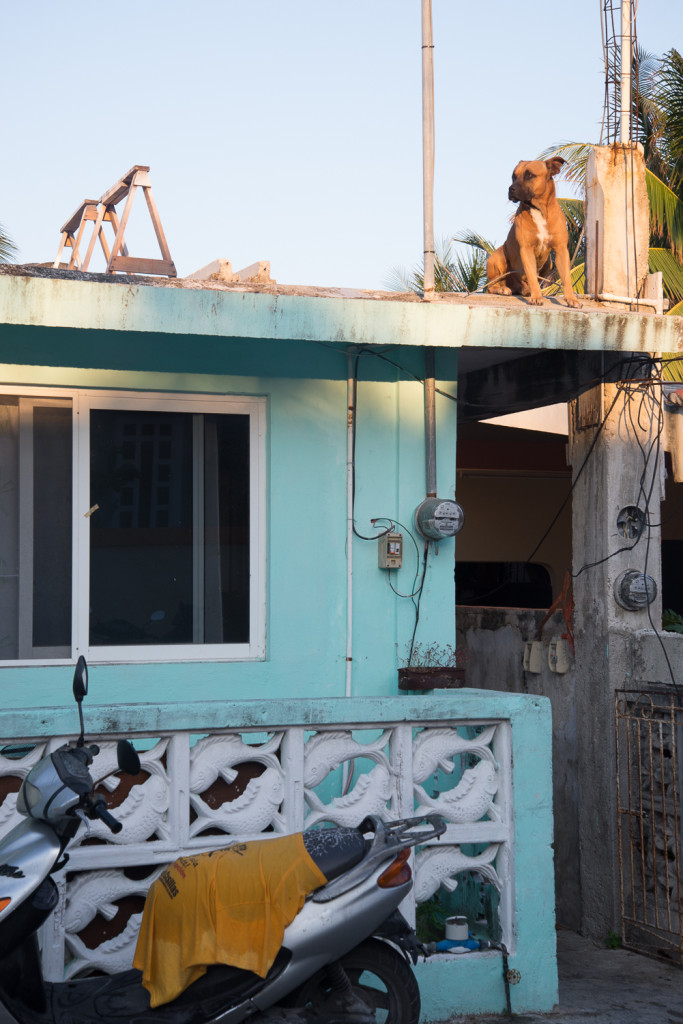
Great stuff, Marie. I miss the light shows in the Cenotes and Mr. Folds!
yo tambien!
hi marie,
looking forward to your next post!
steve
What a nice surprise and recounting of a great holiday. Even without the bountiful sailfish we may have hoped for. So nice to share the Lily M with you. Would love a copy of your ‘preparing the Lily M for the hunt’ photo.
Loved the cenotes after Isla Mujeres. Your photos capture the light really well. Extraordinary beauty.
Kind regards,
Judi
Hope to cross paths with you again, Judi! After seeing Jim’s shots, I realize I was so focused on the whalesharks and mantas that I didn’t even realize what a terrific underwater model you are!-Marie